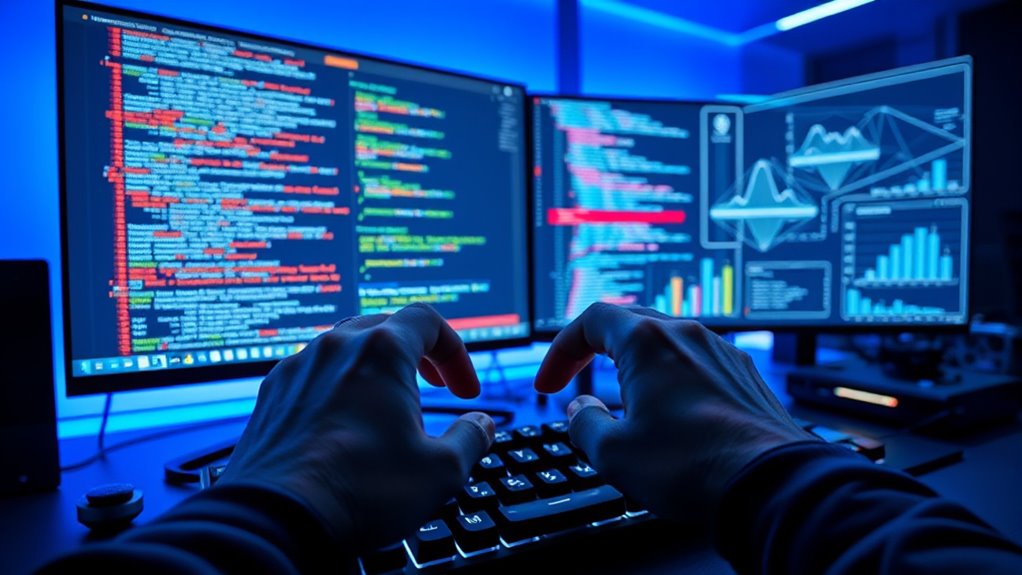AI coders are advancing rapidly, but they’re not yet fully ready for production. While they can generate functional code from simple prompts, issues like data bias, lack of transparency, and the need for human oversight remain. You must review and manage their outputs carefully to guarantee safety and ethical standards. If you want to understand how to navigate these challenges and deploy AI coding tools responsibly, there’s more to discover below.
Key Takeaways
- AI coders can streamline development but still require human oversight to ensure reliability and correctness before deployment.
- The quality of training data critically affects AI-generated code, impacting security, fairness, and bias.
- Ethical and security concerns necessitate careful review and responsible management of AI-produced code in production environments.
- Transparency and explainability are essential for trust and accountability in AI-generated code used in production.
- Current AI coders are not fully autonomous and need human review to mitigate risks and ensure safe deployment.

Have you ever wondered how AI coders are transforming the way software moves from development to deployment? These advanced tools can generate code from simple text prompts, streamlining development processes and opening new possibilities. But as promising as this technology is, it also raises important questions about ethics challenges and reliance on training data. When AI models are trained on vast datasets, they learn patterns and structures that help them produce code, but these datasets aren’t perfect. They often contain biases, gaps, or outdated information, which can lead to errors or unintended behaviors when the AI generates code for real-world applications. You need to be aware that the quality and diversity of training data directly influence the reliability of AI coders. If the data is biased, the code they produce might reflect those biases, potentially leading to ethical concerns or even security vulnerabilities. For instance, an AI trained on code that lacks diversity in programming languages or styles might struggle to adapt to specific project requirements, or worse, embed problematic practices. As a developer, you must consider how these training data issues could impact your project’s integrity and compliance with ethical standards. Relying solely on AI-generated code without proper oversight can be risky, especially when it comes to sensitive or critical systems where security and fairness are paramount. Furthermore, the ethical challenges extend beyond data quality. You should question how transparent the AI’s decision-making process is, whether its outputs are explainable, and if it’s free from biases that could harm users or violate ethical norms. Trusting an AI coder means ensuring it adheres to responsible AI principles, which include fairness, accountability, and transparency. As you prepare to deploy AI-generated code into production environments, it’s vital to implement checks and balances. This involves reviewing generated code thoroughly, understanding the limitations of the training data, and continuously updating the models with more diverse and representative datasets. You should also advocate for clear guidelines on how AI can be integrated responsibly into your workflow, balancing efficiency gains with ethical considerations. Ultimately, while AI coders can greatly accelerate development and reduce manual effort, they’re not yet ready to operate independently in production without human oversight. The ethical challenges tied to training data remind you that AI is a tool—powerful, yes, but requiring careful management to guarantee it benefits everyone without unintended consequences. As you navigate this evolving landscape, keep ethical standards at the forefront, and remember that responsible use of AI is key to harnessing its full potential safely and effectively.
Frequently Asked Questions
How Do AI Coders Handle Complex or Ambiguous Requirements?
When handling complex or ambiguous requirements, you rely on AI coders’ contextual understanding to interpret the nuances. They analyze surrounding information and previous data to resolve ambiguity, enabling more accurate code generation. You can enhance this process by providing clearer instructions or additional context. This way, AI coders improve their ambiguity resolution skills, producing solutions that better align with your expectations, even in challenging or uncertain scenarios.
What Are the Best Practices for Integrating Ai-Generated Code Into Existing Systems?
Did you know that 85% of software failures are due to integration issues? To seamlessly incorporate AI-generated code into your existing system, you should prioritize version control and thorough integration testing. These practices help catch errors early, guarantee compatibility, and maintain stability. By carefully managing updates and conducting rigorous tests, you can confidently deploy AI code, reducing risks and boosting your system’s reliability.
How Do AI Coders Ensure Compliance With Industry Standards and Regulations?
You guarantee compliance with industry standards and regulations by integrating regulatory compliance checks into your AI coding process. You review the generated code thoroughly, aligning it with ethical standards and legal requirements. Implement automated testing for compliance, and stay updated on evolving regulations. Regular audits and collaboration with compliance experts help you maintain high ethical standards, minimizing risks and ensuring your AI-generated code meets all necessary industry and legal standards.
What Are the Common Pitfalls When Deploying Ai-Generated Code in Production?
Deploying AI-generated code can be like walking a tightrope—you must balance efficiency with risk. Common pitfalls include skipping thorough code review, which lets bugs slip through, and neglecting bias mitigation, risking unfair outcomes. You need to test rigorously and guarantee compliance. Without proper oversight, AI code can introduce vulnerabilities or ethical issues, so stay vigilant and treat AI outputs as a starting point, not the final step.
How Is the Quality and Security of Ai-Produced Code Verified Before Deployment?
You verify AI-produced code quality and security by conducting thorough code reviews and security audits before deployment. You examine the code for bugs, inefficiencies, and vulnerabilities, ensuring it meets standards. Automated tools can assist in identifying security risks, but manual reviews remain essential. By combining these practices, you can confidently deploy AI-generated code, knowing it’s reliable and secure, reducing potential issues in production environments.
Conclusion
So, are AI coders truly ready to go from experiments to production? The potential is undeniable, but the hurdles remain. As technology advances, you’ll want to watch closely—because what’s coming next could reshape how we write and deploy code forever. Will they deliver flawless results or stumble at the last mile? The future’s uncertain, but one thing’s clear: the shift is happening, and you won’t want to miss what’s coming next.









